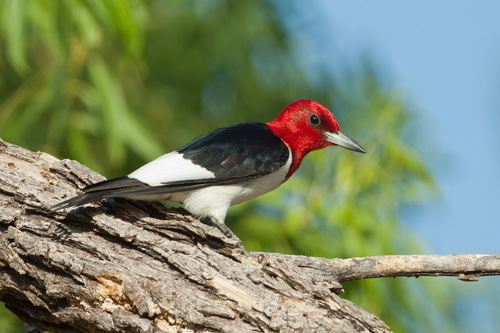
Red-headed Woodpecker
The Red-headed Woodpecker (Melanerpes erythrocephalus) is a striking, medium-sized woodpecker easily recognized by its entirely crimson head, contrasting sharply with its black and white body. Unlike many woodpeckers that have some red on their heads, in this species, the entire head and throat are a deep, vibrant red. This bold coloration makes it one of the most easily identifiable North American birds. It plays a crucial role in forest ecosystems by controlling insect populations and creating nesting cavities used by other species. The Red-headed Woodpecker has also held some cultural significance, appearing in Native American folklore and as a symbol of resilience.
19-25 cm
Length
33-43 cm
Wingspan
Near Threatened
Conservation Status
Distribution
The Red-headed Woodpecker is primarily found in North America, east of the Rocky Mountains. Its range extends from southern Canada (Manitoba, Ontario, Quebec) south through the eastern and central United States to the Gulf Coast and Florida. Some populations are migratory, with northern birds moving south for the winter, while others are year-round residents.
Lifespan
Up to 9-10 years in the wild (though average lifespan is likely shorter).
Red-headed Woodpecker's Habitat
Habitat Types
Open woodlands, Savannas, Forest edges, Parks, Agricultural areas with scattered trees, River groves
Climate Zones
Temperate, Subtropical
Adaptations
Red-headed Woodpeckers prefer habitats with open areas for foraging and dead or decaying trees for nesting and roosting. They have strong, sharp claws for gripping bark and a stiff tail that acts as a prop while climbing. Their strong bill is adapted for drilling into wood.
Variations
While generally considered monotypic (no recognized subspecies), some slight regional variations in size and plumage intensity have been observed, but these are not formally classified.
Appearance
Breeding Plumage
Adults have the same plumage year-round. Juveniles have a grayish-brown head that gradually turns red over their first year.
Seasonal Feather Changes
No significant seasonal variations in adults.
Sex Based Plumage Differences
Males and females have identical plumage.
Notable Features
Entirely red head, neck, and throat., Black back and upperwings., Large white wing patches, visible in flight., White underparts., Black tail with white outer tail feathers.
Diet and Feeding
Primary Foods
Insects, Seeds, Nuts, Fruits, Berries, Occasionally small vertebrates (e.g., nestlings, eggs)
Foraging Behavior
Red-headed Woodpeckers are versatile foragers. They catch insects in the air (flycatching), glean them from leaves and bark, and drill into wood. They also store food, particularly nuts and acorns, in crevices and tree cavities for later consumption (caching).
Specializations
Their strong bill and skull are adapted for hammering and excavating wood. They also have a long, barbed tongue for extracting insects from crevices.
Seasonal Diet Variations
Their diet shifts seasonally. In summer, they consume more insects, while in fall and winter, they rely more on nuts, seeds, and stored food.
Behavior
Social Structure
Red-headed Woodpeckers are generally solitary or found in pairs during the breeding season. They can be aggressive and territorial, defending their nesting and feeding areas from other woodpeckers and birds.
Communication
A variety of calls, including a loud, harsh 'churr' or 'queer' call., Drumming on trees (both for communication and foraging).
Migration
Some populations are migratory, while others are resident. Migratory birds typically move south in the fall and return north in the spring. The extent and timing of migration vary depending on food availability and weather conditions.
Territorial or Group Behaviors
Highly territorial, especially during the breeding season. They will aggressively defend their nests and food sources from intruders, including other Red-headed Woodpeckers and other species.
Conservation
Threats
Habitat loss (loss of dead trees and open woodlands), Competition with European Starlings for nest cavities, Collisions with vehicles, Pesticide exposure
Protection Programs
Habitat restoration and management (e.g., preserving dead trees), Nest box programs (though competition with starlings can be a problem), Monitoring programs
Local National Laws
Protected under the Migratory Bird Treaty Act in the United States.
Population Trend
Decreasing
Population Estimates
Estimated global population of 1.8 million (Partners in Flight)
Interesting Facts
They are one of the few woodpecker species known to store food extensively.
This behavior, called caching, helps them survive during periods of food scarcity.
They can catch insects in flight, like flycatchers.
This is unusual for woodpeckers, which typically forage on tree trunks and branches.
They are known to be very aggressive.
They will fiercely defend their territories and have been observed attacking much larger birds, even hawks.
Red-headed Woodpeckers sometimes reuse nest cavities.
However, they often excavate a new cavity each year.
Faqs about Red-headed Woodpecker
Why is the Red-headed Woodpecker's head completely red?
The bright red coloration likely plays a role in species recognition and mate attraction. The pigments responsible for the red color are carotenoids, which are obtained from their diet.
Are Red-headed Woodpeckers endangered?
They are currently listed as Near Threatened by the IUCN. Their populations have declined significantly in recent decades due to habitat loss and other factors.
What can I do to help Red-headed Woodpeckers?
You can help by preserving dead trees on your property (if safe to do so), providing a source of fresh water, and avoiding the use of pesticides. Supporting conservation organizations that work to protect woodpecker habitat is also beneficial.
Do Red-headed Woodpeckers come to bird feeders?
Yes, they may visit bird feeders, especially those offering suet, peanuts, or sunflower seeds.
Copyright @ Nature Style Limited. All Rights Reserved.
 English
English